- Accueil
- Pages cachées
- 08 Novembre 2023 NEWS
08 Novembre 2023 NEWS
INSTITUT SUPERIEUR D'ANTHROPOLOGIE
INSTITUT OF ANTHROPOLOGY
COURS ONLINE – COURS A DISTANCE
INSCRIPTIONS OUVERTES
REGISTER NOW
ALBANIE – 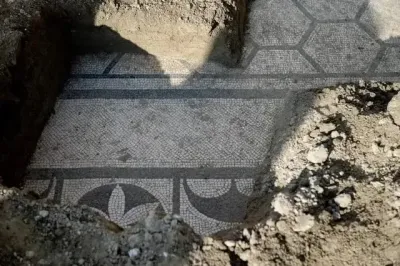 Durrës - In the port city of Durrës, on the Adriatic Sea in western Albania, a unique mosaic dating back 1900 years was found. As one of the oldest and most significant port cities in the Balkans, Durrës is 34 kilometers from Tirana. With nearly 3.000 years of history, it is Albania’s most ancient city or the eternal city over the Adriatic Sea. Its foundation dates back to 627 B.C., when the Corinthians and settlers from Corcyra invaded the Taulants’ Illyrian territory. It later passed to the Romans, who called it Dyrrhachium. It thereby became the most important port of Illyricum. In the 4th century, it became the capital of Epirus Nova (a Roman province). The mosaic was unearthed during works for opening the foundations for the reconstruction of a high school. This mosaic composed of dark blue and white stones with geometric and floral figures belongs to the end of the 1st century and the beginning of the 2nd century and is part of a luxurious villa that was located near the Durrës amphitheater. So far, only a portion of this mosaic, which is estimated to cover an area of 60 square meters, has been discovered. In addition to the mosaic, a 3-meter-high part of the wall on the eastern side, as well as several other objects, was discovered.
Durrës - In the port city of Durrës, on the Adriatic Sea in western Albania, a unique mosaic dating back 1900 years was found. As one of the oldest and most significant port cities in the Balkans, Durrës is 34 kilometers from Tirana. With nearly 3.000 years of history, it is Albania’s most ancient city or the eternal city over the Adriatic Sea. Its foundation dates back to 627 B.C., when the Corinthians and settlers from Corcyra invaded the Taulants’ Illyrian territory. It later passed to the Romans, who called it Dyrrhachium. It thereby became the most important port of Illyricum. In the 4th century, it became the capital of Epirus Nova (a Roman province). The mosaic was unearthed during works for opening the foundations for the reconstruction of a high school. This mosaic composed of dark blue and white stones with geometric and floral figures belongs to the end of the 1st century and the beginning of the 2nd century and is part of a luxurious villa that was located near the Durrës amphitheater. So far, only a portion of this mosaic, which is estimated to cover an area of 60 square meters, has been discovered. In addition to the mosaic, a 3-meter-high part of the wall on the eastern side, as well as several other objects, was discovered.
1900 years old a rare mosaic was discovered in Durrës, Albania - Arkeonews
ARABIE SAOUDITE – 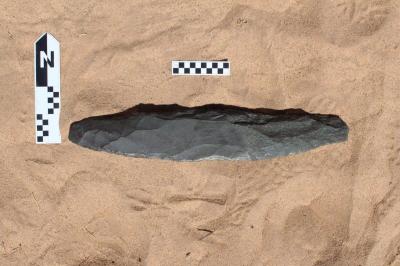 Qurh - The Royal Commission for AlUla (RCU) of Saudi Arabia has announced that archeological excavation teams at the Qurh site in AlUla Governorate have discovered a Paleolithic Age hand axe estimated to be more than 200,000 years old. Qurh (AL-Mabiyat) is located near the village of Mugheira, some 20 Kilometers south of the modern town of AlUla. This strong instrument, crafted from comfortable basalt stone and measuring 51.3 cm in size, reveals traits indicative of chopping or chopping functions. Ongoing studies aim to precisely ascertain the tool’s intended use.
Qurh - The Royal Commission for AlUla (RCU) of Saudi Arabia has announced that archeological excavation teams at the Qurh site in AlUla Governorate have discovered a Paleolithic Age hand axe estimated to be more than 200,000 years old. Qurh (AL-Mabiyat) is located near the village of Mugheira, some 20 Kilometers south of the modern town of AlUla. This strong instrument, crafted from comfortable basalt stone and measuring 51.3 cm in size, reveals traits indicative of chopping or chopping functions. Ongoing studies aim to precisely ascertain the tool’s intended use.
200,000-year-old hand axe discovered in the northern part of Saudi Arabia - Arkeonews
EGYPTE – 
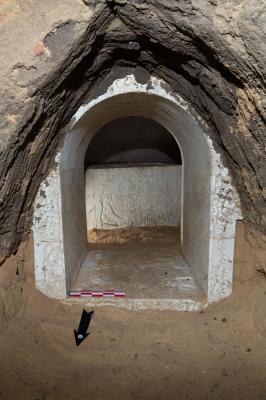 Abousir - An intricately adorned tomb was discovered by Czech Egyptologists working in the Abusir area, Egypt. It belongs to the previously unknown figure pf Djehuti-imhat, a prominent royal Pharaonic scribe in ancient Egypt. Following an in-depth examination of the skeletal remains, it was unveiled that Djehuti-imhat, whose existence dates back to approximately the first millennium BC, passed away at the youthful age of 25. The analysis also disclosed that he suffered from a severe case of osteoporosis. The tomb’s unveiling is expected to contribute to an enhanced comprehension of the historical narratives and traditions of ancient Egypt, as emphasized by the Czech Institute of Egyptology. Secretary General of the Egypt’s Supreme Council of Antiquities, Mostafa Waziri, also underlined the significance of the discovery. The burial chamber of Djehuti-imhat, an enigmatic figure from the twenty-seventh dynasty, contain many intricate scenes and hieroglyphics. Professor Miroslav Bárta, the Director of the Czech Institute of Egyptology, provided insights into the structure of the tomb. He described it as a well-shaped chamber that culminated in a burial room. As reported, the area in the necropolis where the tomb was unearthed had previously revealed the ancient burials of distinguished officials and military leaders. Ancient Tomb of Royal Pharaonic Scribe Discovered in Egypt (greekreporter.com)
Abousir - An intricately adorned tomb was discovered by Czech Egyptologists working in the Abusir area, Egypt. It belongs to the previously unknown figure pf Djehuti-imhat, a prominent royal Pharaonic scribe in ancient Egypt. Following an in-depth examination of the skeletal remains, it was unveiled that Djehuti-imhat, whose existence dates back to approximately the first millennium BC, passed away at the youthful age of 25. The analysis also disclosed that he suffered from a severe case of osteoporosis. The tomb’s unveiling is expected to contribute to an enhanced comprehension of the historical narratives and traditions of ancient Egypt, as emphasized by the Czech Institute of Egyptology. Secretary General of the Egypt’s Supreme Council of Antiquities, Mostafa Waziri, also underlined the significance of the discovery. The burial chamber of Djehuti-imhat, an enigmatic figure from the twenty-seventh dynasty, contain many intricate scenes and hieroglyphics. Professor Miroslav Bárta, the Director of the Czech Institute of Egyptology, provided insights into the structure of the tomb. He described it as a well-shaped chamber that culminated in a burial room. As reported, the area in the necropolis where the tomb was unearthed had previously revealed the ancient burials of distinguished officials and military leaders. Ancient Tomb of Royal Pharaonic Scribe Discovered in Egypt (greekreporter.com)
EUROPE –  - Two studies published today in Current Biology and involving new archaeological and genetic evidence rewrites the history of cats in Europe. The international team of researchers sequenced and analysed both wildcats and domestic cats including 48 modern individuals and 258 ancient samples excavated from 85 archaeological sites over the last 8,500 years. They then assessed the patterns of hybridisation (or interbreeding) after domestic cats were introduced to Europe over 2,000 years ago, and came into contact with native European wildcats.
- Two studies published today in Current Biology and involving new archaeological and genetic evidence rewrites the history of cats in Europe. The international team of researchers sequenced and analysed both wildcats and domestic cats including 48 modern individuals and 258 ancient samples excavated from 85 archaeological sites over the last 8,500 years. They then assessed the patterns of hybridisation (or interbreeding) after domestic cats were introduced to Europe over 2,000 years ago, and came into contact with native European wildcats.
November: Wild and domestic cats | News and features | University of Bristol
BULGARIE- 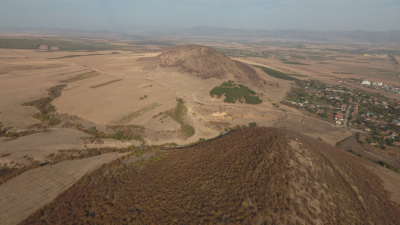 Glufishevo Two settlements from the Late Iron Age were discovered during archaeological excavations near the southeastern village of Glufishevo, the Dr. Simeon Tabakov Regional Historical Museum (RHM) in Sliven said on Monday. Fragments of amphorae show that the inhabitants of the land of Glufishevo during the Late Iron Age imported wine or olive oil from the isand of Thasos. It is highly probable that they also produced and exported locally produced wine. Perhaps the first road connections between settlements also date from this era.
Glufishevo Two settlements from the Late Iron Age were discovered during archaeological excavations near the southeastern village of Glufishevo, the Dr. Simeon Tabakov Regional Historical Museum (RHM) in Sliven said on Monday. Fragments of amphorae show that the inhabitants of the land of Glufishevo during the Late Iron Age imported wine or olive oil from the isand of Thasos. It is highly probable that they also produced and exported locally produced wine. Perhaps the first road connections between settlements also date from this era.
BTA :: Two Late Iron Age Settlements Discovered during Archaeological Excavations in SE Bulgaria
INDE - Mudichu Thalapalli - A geoglyph in the form of a circle, said to be 3,000 years old, has been unearthed on the outskirts of Mudichu Thalapalli in the Medchal-Malkajgiri district of Telangana Etched on a low-lying granitoid hillock, the geoglyph spans 7.5 metres in diameter and has a perfect circular shape. Surrounding the circle is a 30-centimetre-wide rim, and within the circle are two triangles. Seeking to determine the age of the geoglyph, Dr. Sivanagireddy reached out to professor Ravi Korisettar, a prehistoric rock art expert, who dated the geoglyph to the Iron Age, specifically around 1000 BCE. He suggested that this circle might have served as a model for megalithic communities in planning their circular burial sites. Additionally, the team identified several grooves, which they believe to be from the Neolithic period, dating to 4000 BCE, located five metres away from the geoglyph. Also, within one-kilometre radius of the geoglyph’s location, they discovered three prehistoric rock shelters adorned with depictions of bulls, deer, porcupines and human figures wearing masks. According to the team, these artworks date to Mesolithic and Megalithic periods.
‘3,000-year-old Iron Age’ geoglyph circle discovered in Telangana - The Hindu
MEXIQUE – 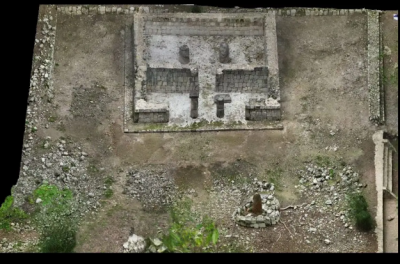 Edzná - Edzná, Meaning “House of the Itzaes”, is a Maya city located in the Mexican state of Campeche. Archaeological evidence suggests that the region was already inhabited during the 5th century BC, emerging into a major population centre around AD 200. The city was deserted around AD 1500, however, the reason for this decline and eventual abandonment remains a mystery. Archaeological works conducted by specialists from the National Institute of Anthropology and History (INAH) of Structure 512 in the Edzná Archaeological Zone have revealed a building with a quadrangular plan. Structure 512 dates from the Early Postclassic period (AD 900 to 1200), however, it was constructed on an earlier building that dates from the Classic period (AD 200 to 600). The works also identified a porticoed entrance with two bays, two columns that supported a roof, and a man-made cavity excavated in the bedrock which likely functioned as a burial tomb. According to the researchers, Structure 512 has architectural similarities with the courtyard-gallery type buildings of Chichén Itzá, used for the performance of religious ceremonies and the deposit of offerings. Chichén Itzá was one of the largest cities from the Maya world, is located in Mexico’s Yucatan State, approximately 307 kilometres from Edzná. Dr Benavides from INAH, said: “In addition to the scope of the architectural styles of Chichén Itzá, its presence in Edzná indicates the links sustained by both cities in the Early Postclassic.”Previous studies have identified that Edzná has architectural signs of the Puuc style, even though it is far from the Puuc Hills sites. This already suggested contact far to the west, however, the new revelation at Structure 512 now indicates that this level of contact stretched much further.
Edzná - Edzná, Meaning “House of the Itzaes”, is a Maya city located in the Mexican state of Campeche. Archaeological evidence suggests that the region was already inhabited during the 5th century BC, emerging into a major population centre around AD 200. The city was deserted around AD 1500, however, the reason for this decline and eventual abandonment remains a mystery. Archaeological works conducted by specialists from the National Institute of Anthropology and History (INAH) of Structure 512 in the Edzná Archaeological Zone have revealed a building with a quadrangular plan. Structure 512 dates from the Early Postclassic period (AD 900 to 1200), however, it was constructed on an earlier building that dates from the Classic period (AD 200 to 600). The works also identified a porticoed entrance with two bays, two columns that supported a roof, and a man-made cavity excavated in the bedrock which likely functioned as a burial tomb. According to the researchers, Structure 512 has architectural similarities with the courtyard-gallery type buildings of Chichén Itzá, used for the performance of religious ceremonies and the deposit of offerings. Chichén Itzá was one of the largest cities from the Maya world, is located in Mexico’s Yucatan State, approximately 307 kilometres from Edzná. Dr Benavides from INAH, said: “In addition to the scope of the architectural styles of Chichén Itzá, its presence in Edzná indicates the links sustained by both cities in the Early Postclassic.”Previous studies have identified that Edzná has architectural signs of the Puuc style, even though it is far from the Puuc Hills sites. This already suggested contact far to the west, however, the new revelation at Structure 512 now indicates that this level of contact stretched much further.
Structure at Edzná suggests long distant links with Chichén Itzá | HeritageDaily - Archaeology News
ALLEMAGNE -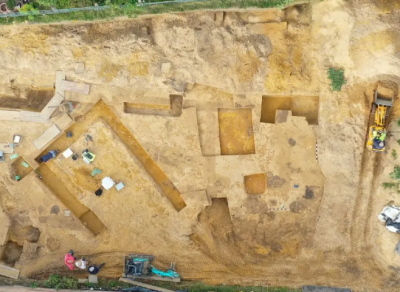 Haltern am See - During the Roman period the site was a major military fortress and civilian colony, which according to historians was likely built by the Emperor Augustus who named it Aliso. This was confirmed in 2010 by excavations conducted by the Archaeological Commission of Westphalia, who determined that the site corresponds to the one described in ancient literature as Aliso. Recent excavations by LWL have found the foundations of two cult temples, one of which was constructed of wood with a rectangular plan measuring 30 square metres and accessed via a 5 metre wide entrance way marked by two wooden columns on either side. Both temples are located in a 2,000 square metre complex previously examined in 1928, which Westphalian chief archaeologist Prof. Dr. August Stieren, initially identified as meeting house for military personnel. In later years the complex was converted to hold a military workshop, evidenced by numerous tools found in situ.“The two rectangular cult temples consisted only of clay frameworks,” says LWL Roman expert Dr. Bettina Tremmel. “But they were based on the typical large podium temples made of stone that could be found in numerous Roman cities at the time of Emperor Augustus.” According to the researchers, the discovery is unique as there have been no other examples of cult buildings previously unearthed in Roman military installations. Adjacent to the cult temples is a circular ditch which has been preserved as a discoloration in the oil. The depth and the Roman finds it contains are comparable to the Roman burial ground in Haltern, however, the practice of burials within such settlements was forbidden under Roman law.
Haltern am See - During the Roman period the site was a major military fortress and civilian colony, which according to historians was likely built by the Emperor Augustus who named it Aliso. This was confirmed in 2010 by excavations conducted by the Archaeological Commission of Westphalia, who determined that the site corresponds to the one described in ancient literature as Aliso. Recent excavations by LWL have found the foundations of two cult temples, one of which was constructed of wood with a rectangular plan measuring 30 square metres and accessed via a 5 metre wide entrance way marked by two wooden columns on either side. Both temples are located in a 2,000 square metre complex previously examined in 1928, which Westphalian chief archaeologist Prof. Dr. August Stieren, initially identified as meeting house for military personnel. In later years the complex was converted to hold a military workshop, evidenced by numerous tools found in situ.“The two rectangular cult temples consisted only of clay frameworks,” says LWL Roman expert Dr. Bettina Tremmel. “But they were based on the typical large podium temples made of stone that could be found in numerous Roman cities at the time of Emperor Augustus.” According to the researchers, the discovery is unique as there have been no other examples of cult buildings previously unearthed in Roman military installations. Adjacent to the cult temples is a circular ditch which has been preserved as a discoloration in the oil. The depth and the Roman finds it contains are comparable to the Roman burial ground in Haltern, however, the practice of burials within such settlements was forbidden under Roman law.
Cult temples found at Haltern Roman Camp | HeritageDaily - Archaeology News
FRANCE – 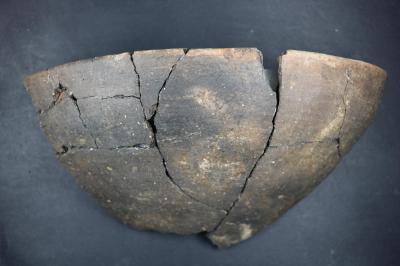
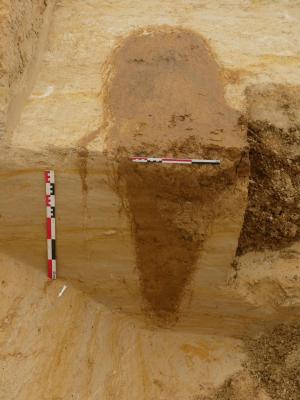 Arc-sur-Tille - Les archéologues de l’Inrap ont fouillé une parcelle de 9000 m² à Arc-sur-Tille, révélant des fosses dites de chasse et divers vestiges. Les plus denses se rapportent au Néolithique ancien / moyen et à la Protohistoire ancienne. Ils apportent de nouvelles données sur l’occupation de cette plaine alluviale. Douze fosses en Y sont reparties sur l’ensemble de la surface prescrite. Peu de mobilier (rares tessons céramique et ossements) provient de leur comblement. Une datation radiocarbone systématique de ces structures a été réalisée et a permis de les associer à une période chronologique (Néolithique ancien et /moyen, âge du Bronze ancien à final). Aucune répartition spatiale en fonction de la datation n’est perceptible, certaines fosses du Néolithique et de l'âge du Bronze sont même très proches. La datation de charbons de bois dans le comblement primitif et final montre un même intervalle chronologique au sein des fosses, ce qui tend à proposer un comblement assez rapide et non une utilisation sur une très longue durée d’une même fosse. Quatre fosses polylobées ont été découvertes lors du décapage. Deux d’entre elles ont livré une assez grande quantité de tessons céramique, une fusaïole et de la faune. Quelques pièces de macro-outillage et des fragments d’objets métalliques s’ajoutent au corpus de mobilier. Des traces de battitures ont pu être détectées à l’aimant. Ce fait est avéré sur de nombreuses polylobées de cette période dans la région. La céramique permet d’attribuer ces fosses à la période du Hallstatt C2 (700-600 av. J.-C.).
Arc-sur-Tille - Les archéologues de l’Inrap ont fouillé une parcelle de 9000 m² à Arc-sur-Tille, révélant des fosses dites de chasse et divers vestiges. Les plus denses se rapportent au Néolithique ancien / moyen et à la Protohistoire ancienne. Ils apportent de nouvelles données sur l’occupation de cette plaine alluviale. Douze fosses en Y sont reparties sur l’ensemble de la surface prescrite. Peu de mobilier (rares tessons céramique et ossements) provient de leur comblement. Une datation radiocarbone systématique de ces structures a été réalisée et a permis de les associer à une période chronologique (Néolithique ancien et /moyen, âge du Bronze ancien à final). Aucune répartition spatiale en fonction de la datation n’est perceptible, certaines fosses du Néolithique et de l'âge du Bronze sont même très proches. La datation de charbons de bois dans le comblement primitif et final montre un même intervalle chronologique au sein des fosses, ce qui tend à proposer un comblement assez rapide et non une utilisation sur une très longue durée d’une même fosse. Quatre fosses polylobées ont été découvertes lors du décapage. Deux d’entre elles ont livré une assez grande quantité de tessons céramique, une fusaïole et de la faune. Quelques pièces de macro-outillage et des fragments d’objets métalliques s’ajoutent au corpus de mobilier. Des traces de battitures ont pu être détectées à l’aimant. Ce fait est avéré sur de nombreuses polylobées de cette période dans la région. La céramique permet d’attribuer ces fosses à la période du Hallstatt C2 (700-600 av. J.-C.).
Aucun habitat de cette période n’a pu être fouillé sur l’emprise mais il devait se situer dans les environs proches. Des trous de poteau et fosses ayant livré peu de mobilier (rares micro tessons céramique) ont pu être attribués à la période de l’âge du Bronze par datation radiocarbone. Ils illustrent une occupation synchrone à certaines fosses de chasse.
Pour la protohistoire ancienne, de nombreux sites et occupations de cette période ont pu être appréhendés depuis plusieurs décennies dans la plaine de la Tille. La fouille d’Arc-sur-Tille, La Corvée du Dos d’Ane a révélé des vestiges néolithiques et de la Protohistoire ancienne. Ils ne sont pas très denses mais apportent des données sur l’occupation ancienne de ce bord de rivière et sa place dans l’évolution du paysage naturel. Les observations géomorphologiques menées permettent de restituer l’histoire environnementale de la région au cours du dernier million d’années.
Actualité | Fosses de chasse et occupation protohistoriques �... | Inrap
FRANCE - 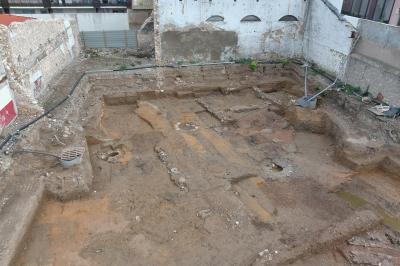 -Narbonne - La fouille intervient dans un quartier situé au nord-ouest du cœur historique de la ville, créé dans le courant du XIXe siècle à la faveur du développement du commerce vinicole. Tout comme au XIXe siècle, l’activité de ce quartier excentré de la ville antique, urbanisé plus d’un siècle et demi après la création de la Colonia Narbo Martius en -118, est toute tournée vers le commerce et le stockage de marchandises. Ce sont ainsi trois voire quatre entrepôts qui ont pu être partiellement dégagés sur ces trois fouilles, auxquels s’ajoutent de probables boutiques ainsi que de l’habitat. Sur le site actuellement fouillé, plusieurs structures ont été mises en évidence. Le plan en cours d’établissement comprend ainsi plusieurs îlots scandés par deux rues et une ruelle dont certaines sont dotées de canalisations assurant l’évacuation des eaux pluviales et usées. Certaines se recoupent et témoignent des modifications successives dans le réseau hydraulique. De nombreux murs, dont certains épierrés, matérialisent des bâtiments aux sols en terre ou en béton. Certains espaces ont fait l’objet d’un traitement particulier et présentent un niveau d’amphores posées horizontalement de manière à constituer à un vide sanitaire. Ces éléments permettent d’identifier notamment un grand bâtiment, dont le rez-de-chaussée, au sol assaini par le vide sanitaire en amphores, permettait l’entreposage de marchandises diverses, tandis que l’étage (attesté entre autres par des dais de pierre servant de socles de poteaux) devait servir de bureau ou d’habitat, comme le suggèrent les murs en briques de terre crue recouverts d’enduits peints retrouvés écroulés à la suite d’un incendie. Ces découvertes permettent ainsi d’identifier le port fluvial implanté le long de la Robine, en amont de la ville. Il constitue avec l’avant-port maritime dont les vestiges ont été observés en plusieurs points, plus près de la mer (La Nautique, Ile Saint-Martin à Gruissan), un système portuaire complexe dont quelques textes antiques se font l’écho par la richesse et la quantité des marchandises qui y transitent. Cette fouille préventive complète donc nos connaissances sur la ville antique de Narbonne, mais pourra également répondre à une importante problématique de l’archéologie narbonnaise qu’est l’identification du tracé antique de la Robine.
-Narbonne - La fouille intervient dans un quartier situé au nord-ouest du cœur historique de la ville, créé dans le courant du XIXe siècle à la faveur du développement du commerce vinicole. Tout comme au XIXe siècle, l’activité de ce quartier excentré de la ville antique, urbanisé plus d’un siècle et demi après la création de la Colonia Narbo Martius en -118, est toute tournée vers le commerce et le stockage de marchandises. Ce sont ainsi trois voire quatre entrepôts qui ont pu être partiellement dégagés sur ces trois fouilles, auxquels s’ajoutent de probables boutiques ainsi que de l’habitat. Sur le site actuellement fouillé, plusieurs structures ont été mises en évidence. Le plan en cours d’établissement comprend ainsi plusieurs îlots scandés par deux rues et une ruelle dont certaines sont dotées de canalisations assurant l’évacuation des eaux pluviales et usées. Certaines se recoupent et témoignent des modifications successives dans le réseau hydraulique. De nombreux murs, dont certains épierrés, matérialisent des bâtiments aux sols en terre ou en béton. Certains espaces ont fait l’objet d’un traitement particulier et présentent un niveau d’amphores posées horizontalement de manière à constituer à un vide sanitaire. Ces éléments permettent d’identifier notamment un grand bâtiment, dont le rez-de-chaussée, au sol assaini par le vide sanitaire en amphores, permettait l’entreposage de marchandises diverses, tandis que l’étage (attesté entre autres par des dais de pierre servant de socles de poteaux) devait servir de bureau ou d’habitat, comme le suggèrent les murs en briques de terre crue recouverts d’enduits peints retrouvés écroulés à la suite d’un incendie. Ces découvertes permettent ainsi d’identifier le port fluvial implanté le long de la Robine, en amont de la ville. Il constitue avec l’avant-port maritime dont les vestiges ont été observés en plusieurs points, plus près de la mer (La Nautique, Ile Saint-Martin à Gruissan), un système portuaire complexe dont quelques textes antiques se font l’écho par la richesse et la quantité des marchandises qui y transitent. Cette fouille préventive complète donc nos connaissances sur la ville antique de Narbonne, mais pourra également répondre à une importante problématique de l’archéologie narbonnaise qu’est l’identification du tracé antique de la Robine.
Actualité | Fouille d'un quartier du port fluvial antique de ... | Inrap
ALLEMAGNE –  Freising - Researchers working in Germany found a skeleton with a prosthetic hand attached to its left arm, replacing fingers that had likely been amputated. Workers doing pipe maintenance were the first ones to find the skeleton in a grave in the town of Freising. Radiocarbon dating of the skeleton revealed that the man wearing the prosthesis was between 30 and 50 years old at the moment of his death, which likely happened between 1450 and 1620. This means, the researchers said, that even at that time, people were already thinking about how to make life easier for amputees. Believe it or not, this isn’t the first Middle Age prosthetic ever discovered, and it’s not the oldest either. Around 50 comparable prostheses from the late Middle Ages or early modern period are currently known in Central Europe. These include both simple, immobile prostheses (like the one found in Freising) and those with mechanical components, such as the one used by the famous Bavarian knight Götz von Berlichingen after 1530. “The hollow hand prosthesis of the left hand added four fingers. The index, middle, ring and little fingers are individually molded from sheet metal and are immobile. The finger replicas are slightly curved and lie parallel to each other,” Walter Irlinger, a member of the Bavarian State Office for Monument Preservation, said in a release.The prosthetic had some scraps of fabric and leather attached to the metal fingers, suggesting that the fingers used to have a leaved cover and were attached to the man’s hand with straps. The researchers also spotted a gauze-like material inside the fingers, which might have been used to further protect the skin from contact with the metal. How the man lost his hand and what the prosthesis was used for is still a mystery to the researchers. Marks on the remaining left hand bones suggest that the fingers were amputated while the man was alive. The researchers also found a thumb bone cemented to the metal prosthetic, which indicates that the man kept his thumb.
Freising - Researchers working in Germany found a skeleton with a prosthetic hand attached to its left arm, replacing fingers that had likely been amputated. Workers doing pipe maintenance were the first ones to find the skeleton in a grave in the town of Freising. Radiocarbon dating of the skeleton revealed that the man wearing the prosthesis was between 30 and 50 years old at the moment of his death, which likely happened between 1450 and 1620. This means, the researchers said, that even at that time, people were already thinking about how to make life easier for amputees. Believe it or not, this isn’t the first Middle Age prosthetic ever discovered, and it’s not the oldest either. Around 50 comparable prostheses from the late Middle Ages or early modern period are currently known in Central Europe. These include both simple, immobile prostheses (like the one found in Freising) and those with mechanical components, such as the one used by the famous Bavarian knight Götz von Berlichingen after 1530. “The hollow hand prosthesis of the left hand added four fingers. The index, middle, ring and little fingers are individually molded from sheet metal and are immobile. The finger replicas are slightly curved and lie parallel to each other,” Walter Irlinger, a member of the Bavarian State Office for Monument Preservation, said in a release.The prosthetic had some scraps of fabric and leather attached to the metal fingers, suggesting that the fingers used to have a leaved cover and were attached to the man’s hand with straps. The researchers also spotted a gauze-like material inside the fingers, which might have been used to further protect the skin from contact with the metal. How the man lost his hand and what the prosthesis was used for is still a mystery to the researchers. Marks on the remaining left hand bones suggest that the fingers were amputated while the man was alive. The researchers also found a thumb bone cemented to the metal prosthetic, which indicates that the man kept his thumb.
Centuries-old hand prosthetic discovered by archaeologists in Germany (zmescience.com)
